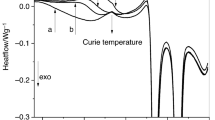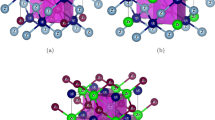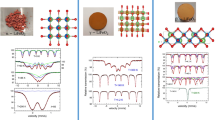Abstract
The heat capacity of the Ni0.667Zr0.333 alloy in amorphous and crystalline states is measured by adiabatic calorimetry from 12 to 325 K. The thermal behavior of the amorphous alloy is studied by differential scanning calorimetry between room temperature and 900 K. Amorphous Ni0.667Zr0.333 is found to crystallize in the range 817–874 K, with a heat evolution maximum at 841 K and an enthalpy increment Δcr H = 3.58 kJ/mol. The heat capacity data are used to evaluate the thermodynamic properties of the Ni0.667Zr0.333 alloy in amorphous and crystalline states in the temperature range 12–325 K.
Similar content being viewed by others
REFERENCES
Borman, R. and Zoltzer, K., Determination of Thermodynamic Functions and Calculation of Phase Diagrams for Metastable Phases, Phys. Status Solidi A, 1992, vol. 131, pp. 691-705.
Blatter, A. and Allmen, M., Reversible Amorphization in Laser-Quenched Titanium Alloys, Phys. Rev. Lett., 1985, vol. 54, no. 19, pp. 2103-2106.
Yan, Z.F., Klassen, T., Mlehaelsen, C., et al., Inverse Melting in the Ti-Cr System, Phys. Rev., 1993, vol. 47, no. 14, pp. 8520-8527.
Nash, P., Phase Diagrams of Binary Nickel Alloys, Metals Park: ASM International, 1991.
Gorbunov, V.E., Gurevich, V.M., and Gavrichev, K.S., Adiabatic Microcalorimeter with an Aneroid-Type Cryostat, Zh. Fiz. Khim., 1982, vol. 56, no. 1, pp. 235-237.
Strelkov, P.G. and Sklyankin, A.A., Prikl. Mekh. Tekh. Fiz., 1960, no. 2, pp. 100-111.
Loss, R.D., IUPAC Commission on Atomic Weights and Isotopic Abundances, Chem. Int., 2001, vol. 23, p. 179.
Gurevich, V.M., Gorbunov, V.E., Gavrichev, K.S., and Khodakovskii, I.L., Calorimeter for Heat Capacity Measurements from 50 to 300 K and the Low-Temperature Heat Capacity of Kogarkoite, Na3SO4F(cr), Geokhimiya, 1999, no. 4, pp. 423-434.
Smith, J.F., Jiang, Q., Luck, R., and Predel, B., The Heat Capacities of Solid Ni-Zr Alloys and Their Relationship to the Glass Transition, J. Phase Equilib., 1991, vol. 12, no. 5, pp. 538-545.
Henaff, M.P., Colinet, C., Pasturel, A., and Buschow, K.H.J., Study of the Enthalpies of Formation and Crystallization in the System Zr-Ni, J. Appl. Phys., 1984, vol. 56, no. 2, pp. 307-310.
Antonian, Z., Guo-hua Tu, and Strom-Olsen, J.O., Crystallization Characteristics of Ni-Zr Metallic Glasses from Ni20Zr80 to Ni70Zr30, J. Appl. Phys., 1983, vol. 54, no. 6, pp. 3111-3116.
Zaitsev, A.I., Zaitseva, N.E., Shakhpazov, E.Kh., and Kodentsov, A.A., Thermodynamic Properties and Phase Equilibria in the Nickel-Zirconium System. The Liquid to Amorphous State Transition, Phys. Chem. Chem. Phys., 2002, vol. 4, no. 24, pp. 6047-6058.
Gavrichev, K.S., Golushina, L.N., Gorbunov, V.E., et al., Heat Capacity and Absolute Entropy of Amorphous Ni—Zr Alloys, Dokl. Akad. Nauk, 2003, vol. 393, no. 5.
Author information
Authors and Affiliations
Rights and permissions
About this article
Cite this article
Gavrichev, K.S., Gorbunov, V.E., Golushina, L.N. et al. Thermodynamic Properties of the Ni0.667Zr0.333 Alloy in Amorphous and Crystalline States. Inorganic Materials 40, 477–482 (2004). https://doi.org/10.1023/B:INMA.0000027593.12681.c8
Issue Date:
DOI: https://doi.org/10.1023/B:INMA.0000027593.12681.c8




